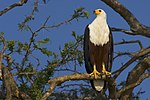Icthyophaga
| Icthyophaga | |
|---|---|

| |
| Fahad’s fish eagle (Icthyophaga humilis) | |
| Scientific classification | |
| Domain: | Eukaryota |
| Kingdom: | Animalia |
| Phylum: | Chordata |
| Class: | Aves |
| Order: | Accipitriformes |
| Family: | Accipitridae |
| Subfamily: | Haliaeetinae |
| Genus: | Icthyophaga Lesson, 1843 |
| Type species | |
| Falco ichthyaetus Horsfield, 1821
| |
| Species | |
|
See text. | |
Icthyophaga or Ichthyophaga is a genus of six species of eagles, closely related to the sea eagles in the genus Haliaeetus. In fact, some taxonomic authorities place this genus within Haliaeetus. Both are native to southeastern Asia, from the Indian subcontinent southeast to Sulawesi. They are smaller than the Haliaeetus eagles, though overlapping in size with the smaller species of that genus. They share similar plumage, with grey heads grading into dull grey-brown wings and bodies, and white belly and legs. They differ in tail colour, with the lesser fish eagle having a brown tail, and the grey-headed fish eagle having a white tail with a black terminal band, and also in size, with the lesser fish eagle only about half of the weight of the grey-headed fish eagle.[1]
Taxonomy[edit]
The genus was established by René-Primevère Lesson in 1843, to accommodate a single species, the grey-headed fish eagle, which is therefore considered as the type species. Lesson used two spellings for its name: Icthyophaga and Icthyiophaga, but not Ichthyophaga.[2][3] Traditionally, this genus was believed to include two species: the lesser fish eagle and the grey-headed fish eagle.[4] Erwin Stresemann and Dean Amadon mistakenly referred to the genus as Ichthyophaga in their work, and this erroneous usage persisted for a long time. However, the name Ichthyophaga actually belongs to a prolecithophoran turbellarian parasite in fish established by Syromiatnikova in 1949.[5][3]
In 2005, a molecular systematic study based on nuclear and mitochondrial genes merged this genus into Haliaeetus.[6] In the same year, Ronald Sluys and Masaharu Kawakatsu proposed a replacement of Ichthyophaga with Piscinquilinus,[7] eliminating the controversial name for both birds and worms. A new family, Piscinquilinidae, has been proposed in 2017 to accommodate Piscinquilinus.[8] However, Ernest Williams and Lucy Bunkley-Williams opposed this proposal and advocated retaining the original name for the turbellarian genus Ichthyophaga.[3]
In 2017, the International Commission on Zoological Nomenclature, following the suggestion of Ernest Williams and Lucy Bunkley-Williams, conserved both the bird genus Icthyophaga and the turbellarian genus Ichthyophaga in Case 3603.[9]
In 2023, based on latest molecular systematic studies, the International Ornithologists' Union resurrected Icthyophaga with its right name and transferred four species from Haliaeetus to this genus.[10] Therefore, this genus now includes the following six species:
| Image | Scientific name | Common name | Distribution | IUCN status |
|---|---|---|---|---|
 |
Icthyophaga leucogaster | White-bellied sea eagle | India and Sri Lanka through Southeast Asia to Australia | LC |
| Icthyophaga sanfordi | Sanford's sea eagle | Solomon Islands | VU | |
 |
Icthyophaga vocifer | African fish eagle | Sub-Saharan Africa | LC |
 |
Icthyophaga vociferoides | Madagascar fish eagle | Madagascar | CR |
 |
Icthyophaga humilis | Lesser fish eagle | Kashmir through southeast India, Nepal, and Burma towards Indochina | NT |
 |
Icthyophaga ichthyaetus | Grey-headed fish eagle | Southeast Asia | NT |
Ecology[edit]
As both the common and generic names suggest, both fish eagle and the grey-headed fish eagle feed largely on fish, caught mainly in fresh water on lakes and large rivers, but also occasionally in salt water in estuaries and along coasts.[1]
References[edit]
- ^ a b del Hoyo, J., Elliott, A., & Sargatal, J., eds. (1994). Handbook of the Birds of the World Vol. 2. Lynx Edicions, Barcelona ISBN 84-87334-15-6.
- ^ Lesson, RP (1843). "Index ornithologique". L'Écho du monde savant et l'Hermès: Journal analytique des nouvelles et des cours scientifiques. Année 10, Tome 5 (Semestre 1): columns 13–15 (page 6) [in French].
- ^ a b c Williams, Ernest H.; Lucy Bunkley-Williams (1 August 2017). "An unnecessary replacement name for Ichthyophaga Syromiatnikova 1949 (Platyhelminthes: Prolecithophora) under Article 56.2; and an unnecessary emendation under Article 33.2.3 and the correct spelling of Icthyophaga Lesson 1843 (Aves: Accipitridae)". The Bulletin of Zoological Nomenclature. 74 (1): 136–137. doi:10.21805/bzn.v74.a037. S2CID 90690137.
- ^ del Hoyo, J.; Elliott, A.; Sargatal, J. (1994). Handbook of the Birds of the World Vol. 2. Barcelona: Lynx Edicions. ISBN 84-87334-15-6.
- ^ Syromiatnikova, I.P. (1949). "A new turbellarian parasitic in fish and called Ichthyophaga subcutanea". Dokl Akad Nauk SSSR. 68: 805–808 (in Russian).
- ^ Lerner, RL; Mindell, DP (2005). "Phylogeny of eagles, old world vultures, and other Accipitridae based on nuclear and mitochondrial DNA". Molecular Phylogenetics and Evolution. 37 (2): 327–346. doi:10.1016/j.ympev.2005.04.010. PMID 15925523.
- ^ Sluys, R.; Kawakatsu, M. (2005). "A replacement name for Ichthyophaga Syromiatnikova 1949 (Platyhelminthes: Prolecithophora) with a nomenclature analysis of its avian senior homonym [sic]". Species Diversity. 10: 63–68. doi:10.12782/specdiv.10.63.
- ^ Laumer, Christopher E.; Giribet, Gonzalo (2017). "Phylogenetic relationships within Adiaphanida (phylum Platyhelminthes) and the status of the crustacean-parasitic genus Genostoma". Invertebrate Biology. 136 (2): 184–198. doi:10.1111/ivb.12169. ISSN 1077-8306.
- ^ ICZN (2017). "Closure of Cases (2127, 3543, 3603, 3721, 3726, 3729, 3738, 3741)". Bulletin of Zoological Nomenclature: 142–143.
- ^ Gill, F; Donsker, D; Rasmussen, P, eds. (2023). IOC World Bird List (v 13.2). doi:10.14344/IOC.ML.13.2 (inactive 31 January 2024).
{{cite book}}: CS1 maint: DOI inactive as of January 2024 (link)

